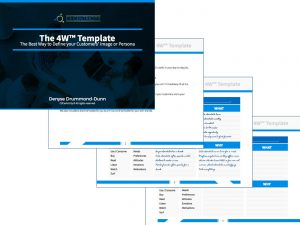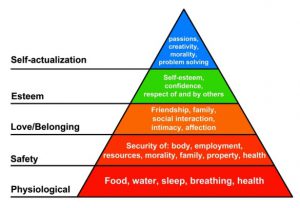We all know that customer centricity is essential; even more so these days with the lockdown in most countries due to the pandemic.
Now more than ever, businesses need to put their customers clearly at the heart of their organisation. But I know that many struggle, even in more normal times, to be customer centric. They just don’t know where to start. Am I right? If you’re one of them, then this article is for you.
This week I give you ten simple actions to accelerate your organisation along its path to an improved customer-first strategy.
#1 Review & Revise the Description of your Target Audience
Do all your brands have a clear description of their target audience? These days we tend to speak about personas or avatars.
 Is it as complete as it should be? If not, then regular readers of C3Centricity will know about and probably already use the 4W™ template for storing all this information. You can download it and get the accompanying workbook here.
Is it as complete as it should be? If not, then regular readers of C3Centricity will know about and probably already use the 4W™ template for storing all this information. You can download it and get the accompanying workbook here.
Include not only your customers’ demographics and consumption / purchasing habits but also information about where they do these things, what values they have that you can tap into and what emotions motivate them to purchase and use your brand.
#2 Assess the Optimum Way of Connecting with Your Customers
Do you know the best way to contact your target customers, as well as their preferred place and time to connect?
Review how you communicate with your customer and what information exchange there is at that time. Is it one-way or two? Are you in a monologue or a dialogue?
Obviously the second is what it should be. You can learn far more about your customers when they are ready to share their information with you.
For an original take on engaging your customers see “You’re missing out on A Free Communication Channel! (Any guesses what it is?).”
#3 Identify the Needs Your Brand is Addressing
 Do you know what needs your customer has and which of them you are tapping into?
Do you know what needs your customer has and which of them you are tapping into?
They certainly have more than one need, but you must identify and address only one.
If you attempt to address more than one and especially if they are not sequential, your customer may be confused.
Mixed brand messages on what the brand can do for them will leave your customers perplexed. This will, in turn, reduce the likelihood that they will be convinced your offer can meet their needs and objectives.
Knowing where your brand sits on Maslow’s hierarchy of needs has one additional benefit. It can increase the success of regional and global launches by identifying cultures with similar levels of a specific need.
For more on this, please read “How to Take Local Brands to Global Success: The 5 Rules to Fortune.”
#4 Make your Customer Everyone’s Responsibility
Is customer care only on the objectives of one or two departments in your organisation? Perhaps it’s only for the care centre employees or merchandisers to do.
It should, in fact, be on everyone’s annual objectives, to watch, listen and engage with your customers regularly. This will help them to understand how their work fits into the company’s objective to satisfy and delight them.
Every employee has a role to play in customer centricity and connecting with the customers on a frequent basis and sharing experiences with colleagues will ensure that everyone understands this.
#5 Plan for the Unthinkable
Do you know where your business is going? Do you know what might happen in the future and what you would do in each situation? How would you react to new laws, new customer demands, and their new sensitivities such as ecology, sustainability, sourcing or ingredients?
It is better to plan for such events before they happen, so that you can quickly react to challenges as well as opportunities.
I am in favour of developing plausible future scenarios, rather than merely following trends. Why? Because everyone follows trends so they provide no competitive advantage. However, by developing scenarios, they will be unique to your organisation and provide a clear path to answer all possible future opportunities and threats.
For more on scenario planning read “5 Business Success Factors (So You’re Ready for Anything!).”
#6 Review Your Business Plans for Customer Centricity
Are your customers clearly identified and described in your plans, as well as the customers of your major competitors?
Review your plans by considering how your customers will react to each of your scheduled actions. Not just the outcomes you are hoping for, but a true detailed analysis based upon your understanding of them and their desires.
Have you planned any actions to surprise and delight them, or are you only relying on the “same old” activities, repeated from year to year?
People get bored quickly and you can also “train” your customers to expect your promotions. They then wait for them before purchasing, often in quantity, and will also eventually become of less interest, and perceived value, to them. Plan at least one unexpected WOW action each year.
#7 Expand Your Innovation Thinking
Are you blocked in an innovation box, relying on your internal technical and expert skills? If you know your customer well you can offer them more successful innovations, perhaps through additional sensorial experiences.
Consider adding sound to taste, colour to services, touch to packaging, aromas to retail displays. Give your customers more reasons to stay with you and they will become more loyal.
For some true inspiration on new ways to approach innovation read “The Best Ways To Improve Innovation With Better Ideation & Insights.”
#8 Stop Testing Your Communications to Death
 I can feel your shock as you read this, but why not review your process for developing your advertising?
I can feel your shock as you read this, but why not review your process for developing your advertising?
If you spent more time and resources reviewing how to connect with your customer, and then reviewed early-stage work up-stream with them, you would be more likely to develop winners.
It would also reduce or totally replace your usual tests just before airing, when in most cases it is too late to change anything.
#9 Define Your Image
Your brand has an image but it might not be what you think it is. Make sure you are measuring it regularly and not only on the attributes that you ideally want to perform well on. You need to include attributes important to your competitors, as well as the category in general.
I so often see biassed attribute lists which, while providing exaggerated, over-positive images, lull companies into a false sense of security. When you are not measuring what is important for your competitors, you will always come out on top.
Another advantage is that the coverage of the total category will be more complete and you may even find a new or adapted positioning that no-one else is currently occupying.
If you’d like to read more about brand image measurement, be sure to check out “What you need to know about Brand Image, Personality & Archetypes.”
#10 Update Your KPI’s
You know that what gets measured gets managed, well are you measuring what needs managing or only the easy metrics to gather?
If you know your customers well, who they are, what they do, what they think of you and your competitors, and then compare these to where you want to take your brand, the metrics you need to be measuring become evident.
Too many organisations rely on financial KPIs alone. Make sure you are not one of them, by adding metrics to cover customer awareness, satisfaction and perception.
I hope this list has helped you to identify a few areas that need revision in your organisation. Actioning even just one of them will improve your customer centricity and your profitability too (according to research).
Of course completing them all will ensure that your customer is really at the center of your business, as well as in the hearts of your employees.
Images sourced from C3Centricity and Dreamstime



